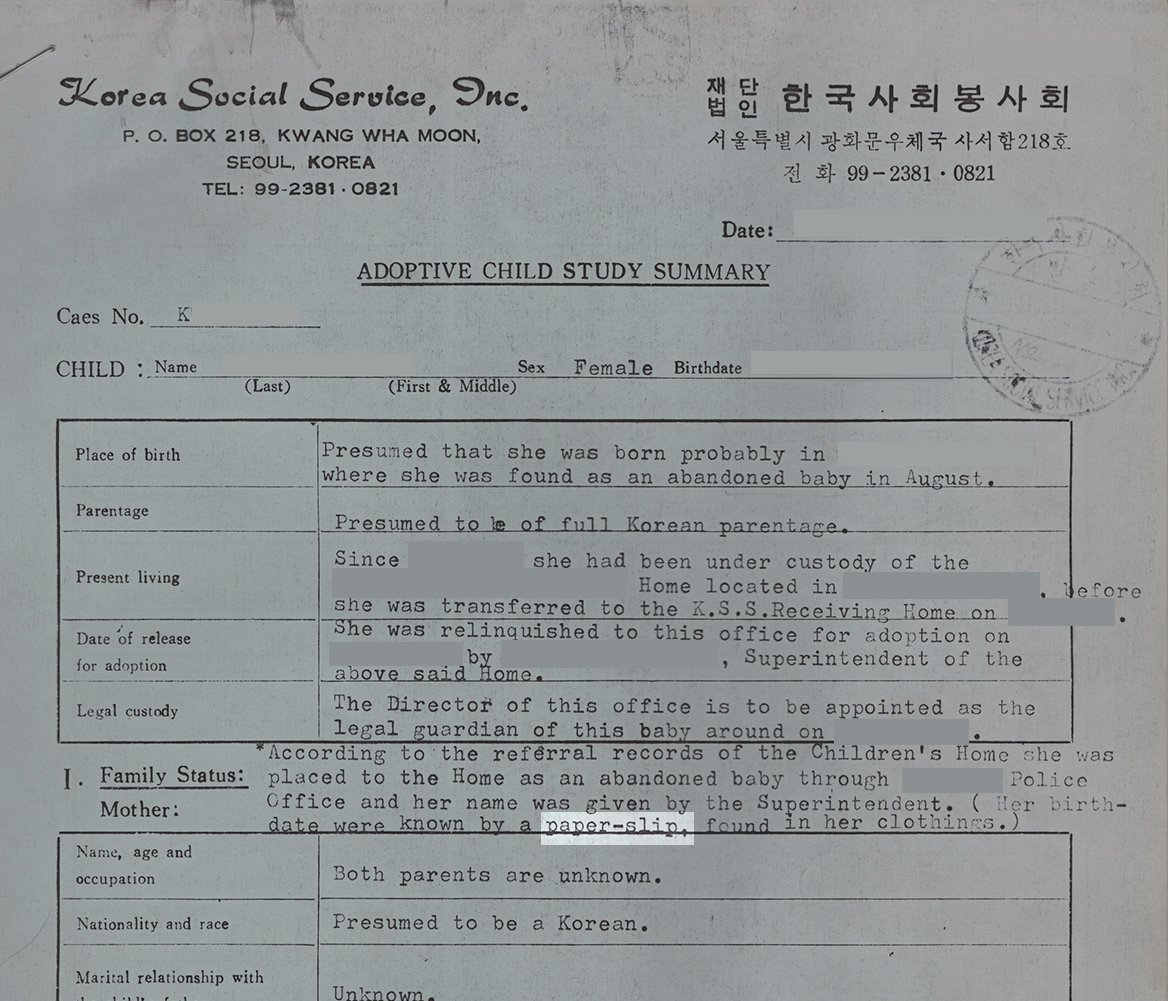
Orphanization Part I.
This Section Applies to Korea Social Service (KSS) Adoptees ONLY.
*Please note that the concept of “Orphanization” applies to all Korean Adoptees. However, the info. below is tailored to how “Orphanization” was specifically applied by Korea Social Service (KSS) to KSS Adoptees.
(To see how “Orphanization” was applied to ALL Korean Adoptees, regardless of their Korean Adoption Agencies, please see the Orphanization Part II page).
”Orphanization” as it relates to the ENGLISH Adoptive Child Study Summary vs. the KOREAN Adoptive Child Study Summary boils down to this: Your English Adoptive Child Study Summary may say that you were “abandoned” without any birth parent information. But secretly KSS kept a more truthful Korean Adoptive Child Study Summary which may, though does not always, contain birth parent name/s and possibly sibling name/s. You can request the Korean Adoptive Child Study Summary through email, which in some, though certainly not all cases, can lead to a birth family reunion.
Please note that even if you request and receive your Korean Adoptive Child Study Summary, this does not mean you automatically have to conduct a search for any birth family members named in the document.
Learn more about the differences between the English and Korean Adoptive Child Study Summary below. Also see the Translation Keys for the various styles of the Korean Adoptive Child Study Summary which KSS used over the years below.
If you are a US Korean Adoptee, and you do not know what your Korean or Western Adoption Agencies were, we highly recommend that you file a FOIA request.
Please note that starting around 1976, there were only 4 major Korean Adoption Agencies: Holt, ESWS, SWS (now KWS) and Korea Social Service (KSS).

Below:
(LEFT) The KSS “English Facing” Adoptive Child Study Summary AND (RIGHT) the KSS “Korean Facing” Adoptive Child Study Summary
The “Adoptive Child Study Summary” was alternately called a “Case Study Record” or a “Child Study Summary” in the 1960s).
Please read this entire page to understand the interaction of the “English Facing” Case Study Record / Child Study Summary / Adoptive Child Study Summary and the “Korean Facing” Adoptive Child Study Summary.
Above LEFT: Examples of various styles over the years of the KSS “English Facing” Adoptive Child Study Summary.
Please Note: This is a 3-4 page document. The examples above are variations of the styles of the 1st page only. Most Adoptees are not told that KSS has a more truthful “Korean Facing” Adoptive Child Study Summary at KSS’ Post Adoption Services building in Seoul. Learn how to request the KSS “Korean Facing” Adoptive Child Study Summary here.
+
Above RIGHT: Examples of various styles over the years of the KSS “Korean Facing” Adoptive Child Study Summary.
Please Note: This 3-4 page document (see image below). The example above is a style of the 1st page only from the 1970s. The document is kept in the back of an Adoptee’s file folder at KSS, and is not meant to be seen by the Adoptee nor the Adoptive Parents. Most Adoptees are not told that KSS has a more truthful “Korean Facing” Adoptive Child Study Summary at KSS’ Post Adoption Services building in Seoul. Learn how to request the KSS “Korean Facing” Adoptive Child Study Summary here.
The Evolution of KSS’ “English Facing” documents.
Apparently KSS’ primary “English Facing” adoption document evolved from:
Case Study Record > Child Study Summary > Adoptive Child Study Summary.
Read more below:
Above: In a fascinating evolution of KSS’ “English Facing” adoption documents, KSS evolved from an earlier “Case Study Record” (we know of an example from 1967) to a “Child Study Summary” in this 1969 example. Eventually this document would become the “Adoptive Child Study Summary” used by KSS in the 1970s, 1980s, 1990s, and presumably until 2012 when KSS closed its adoption business.
It also appears that these 1960s KSS “English Facing” “Case Study Records” and “Child Study Summaries” had more truthful biographical information written on them than later 1970s “Adoptive Child Study Summaries” which appear to contain more false Orphanization language such as “found with a paper-slip” or “memo”. Such false Orphanization language could have presumably been used by KSS in any year, but so far such false Orphanization language seems to have predominated in the 1970s and into the 1980s. However it should be noted that false or incomplete information could have been used by KSS in any year.
Apparently KSS evolved from: Case Study Record > Child Study Summary > Adoptive Child Study Summary.
The 1970s (and early 1980s?) “Korean Facing” Adoptive Child Study Summary.
The document below is the style of “Korean Facing” Adoptive Style Study Summary from the 1970s and possibly the early 1980s.
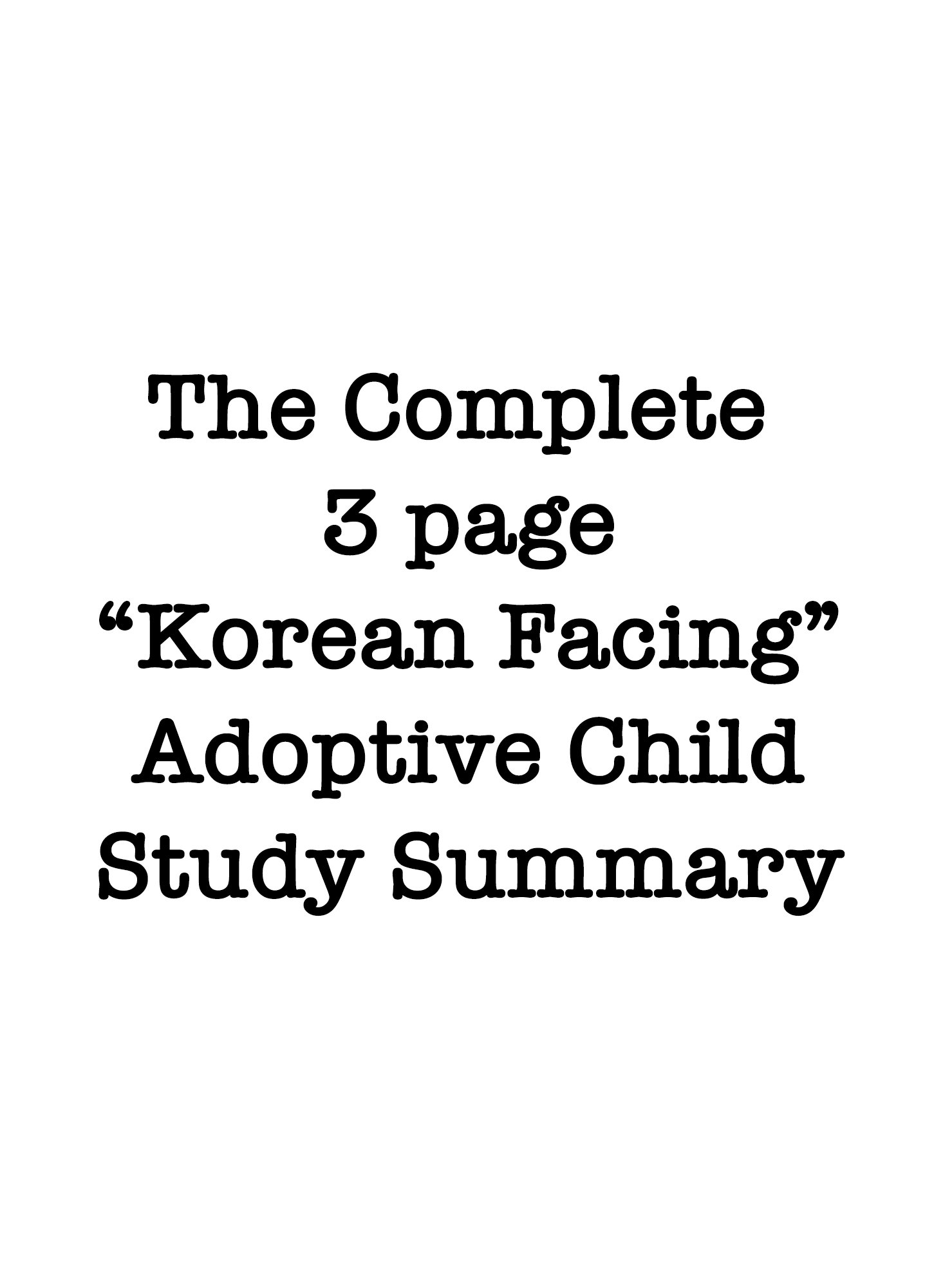
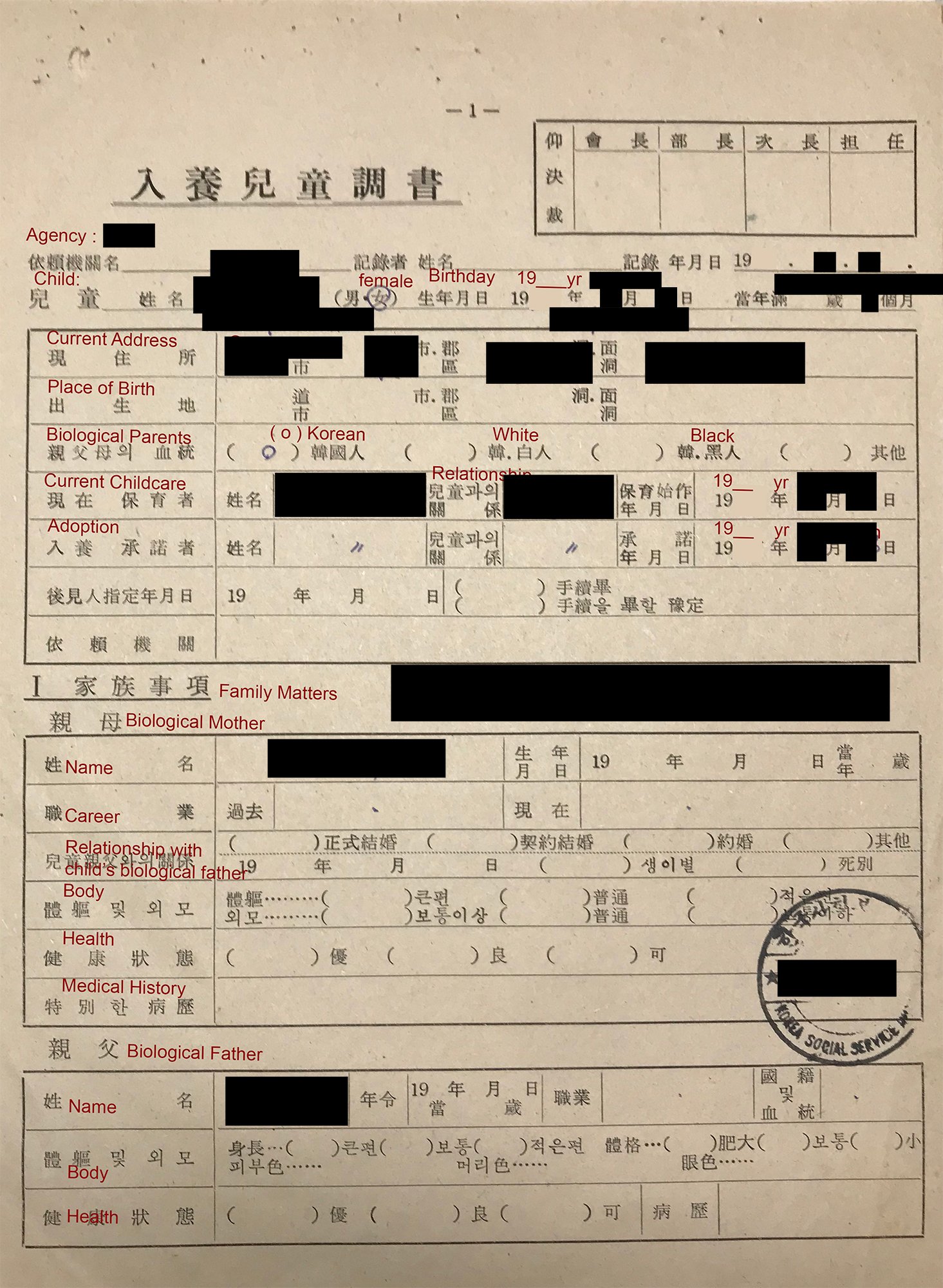
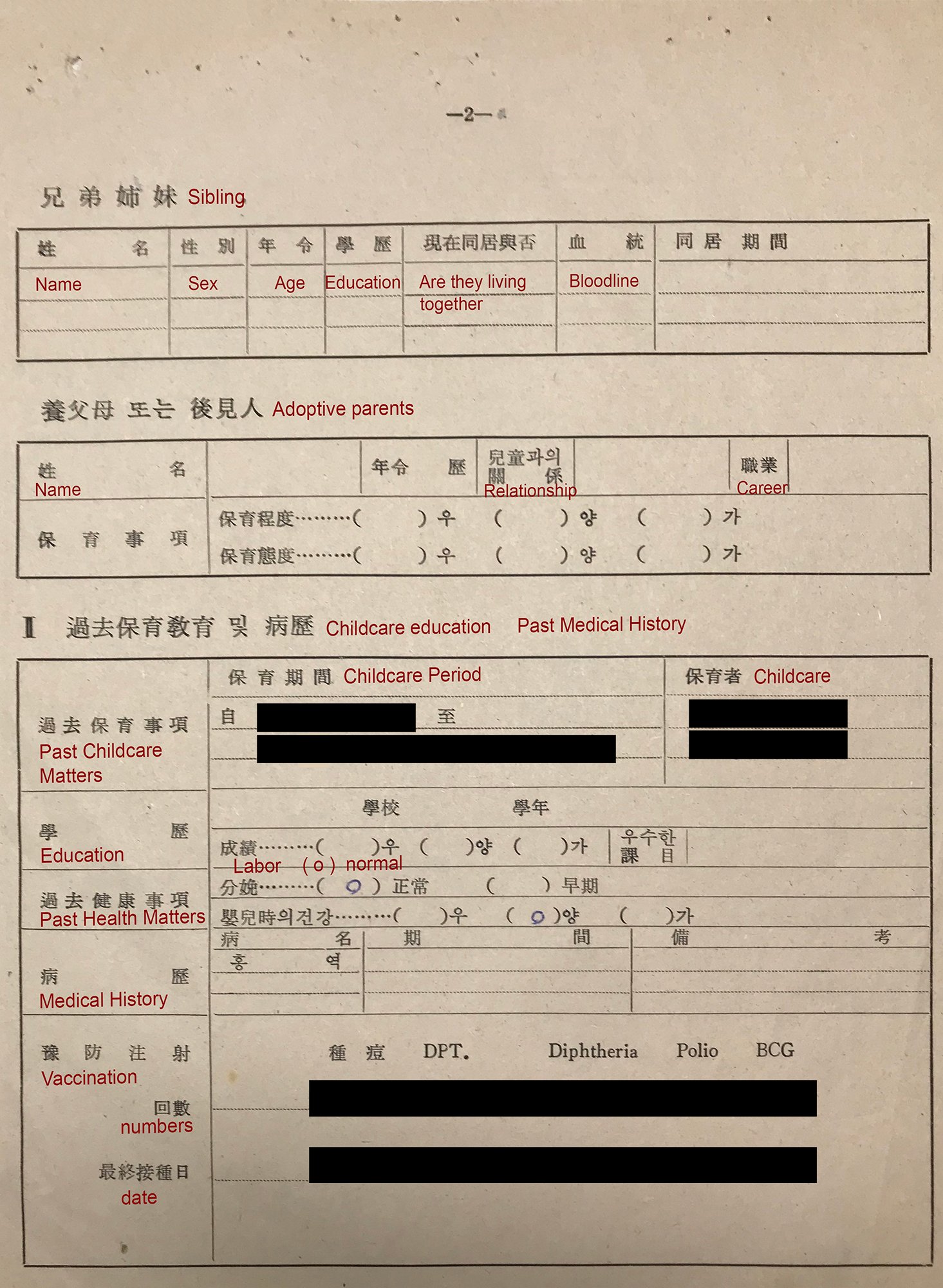
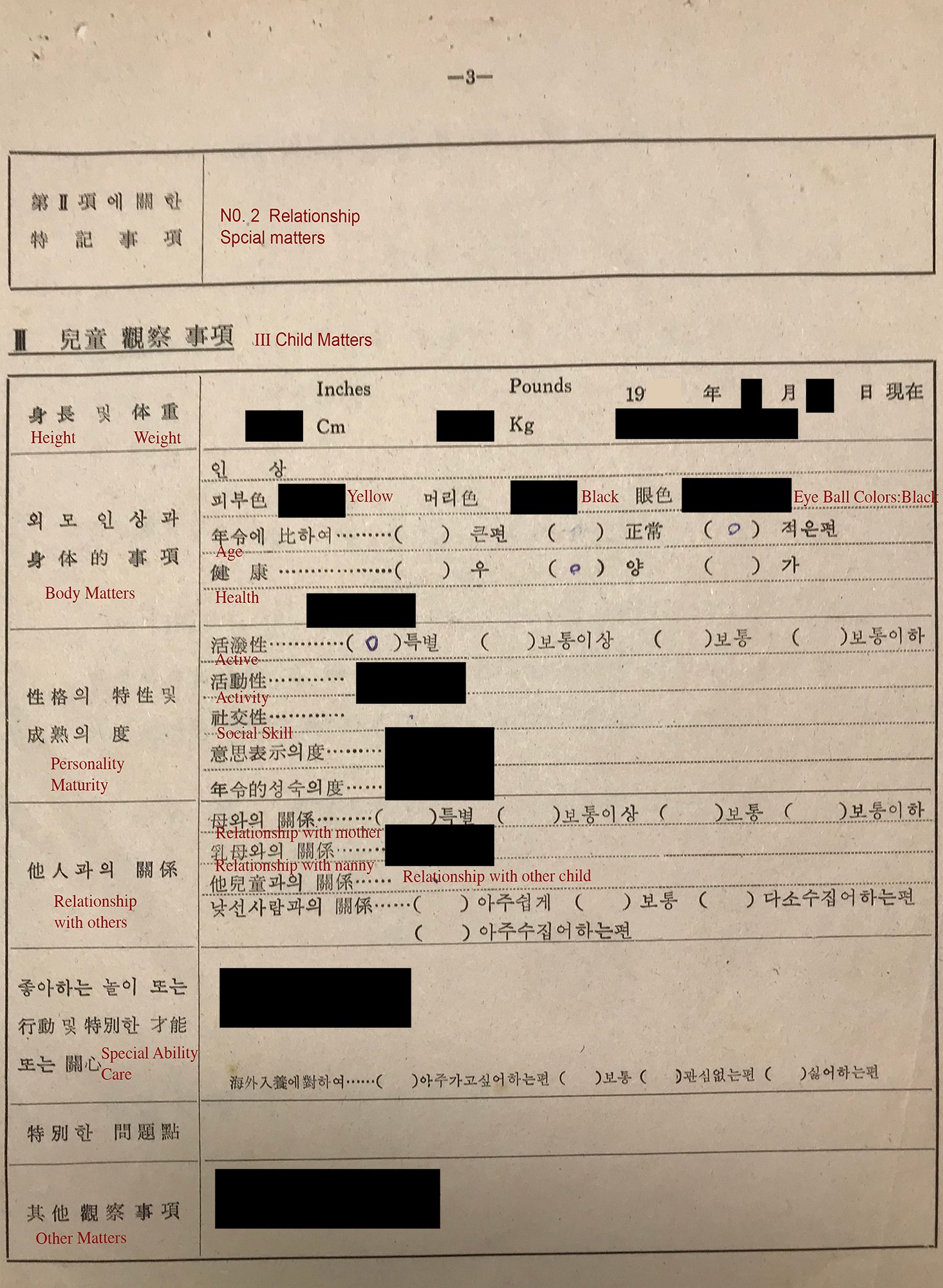
Translation Key: “Korean Facing” Adoptive Child Study Summary.
Below is the translation key for all 3 pages of the “Korean Facing” Adoptive Child Study Summary, generously provided to us by a Korean translator.
Click here to download the Translation Key for the KSS “Korean Facing” Adoptive Child Study Summary (Word document).
Above: Translation key for Page 1 of the “Korean Facing” Adoptive Child Study Summary.
Above: Translation key for Page 2 of the “Korean Facing” Adoptive Child Study Summary.
Above: Translation key for Page 3 of the “Korean Facing” Adoptive Child Study Summary.
The Mid - Late (?) 1980s / 1990s “Korean Facing” Adoptive Child Study Summary.
The document below is the style of what we believe to be the “Korean Facing” Adoptive Style Study Summary from the Mid-Late (?) 1980s / 1990s.
Here is the Translation Key for the KSS Mid - Late (?) 1980s / 1990s "Korean Facing" Adoptive Child Study Summary. KSS' document style for the "Korean Facing" Adoptive Child Study Summary apparently changed over the years, and this is just one of two styles for this document that we know of. (There may be others of which we are unaware).

The KSS “English Facing” Adoptive Child Study Summary:
Learn how KSS used this document in its Adoption Procedure with its Partner Western Adoption Agencies.
This document is VERY important to understand for KSS Adoptees.
Below this section on the “English Facing” Adoptive Child Study Summary, please read the very important section on the “Korean Facing” Adoptive Child Study Summary which contains the more TRUTHFUL information about a KSS Adoptee’s history in Korea.
You were probably not really found with a “paper-slip” or “memo”. Read why so many of us have this copy / paste false “orphanization” statement in our “English Facing” Adoptive Child Study Summaries below.
Please Note: Even if your “English Facing” Adoptive Child Study does NOT specifically mention being found with a “paper-slip” or “memo”, there could still be false “orphanization” information in your paperwork.
Below: Examples of various styles over the years of the KSS “English Facing” Adoptive Child Study Summary.
Please Note: This is a 3-4 page document. The examples below are variations of the styles of the 1st page only.
Understanding the “English Facing” Adoptive Child Study Summary in the context of KSS Adoption Procedure:
The “English Facing” Adoptive Child Study Summary was a document created by KSS and sent to its Partner Western Adoption Agencies at the beginning of the coordinated adoption process between KSS and its Partner Western Adoption Agencies in the US and Europe. The “English Facing” Adoptive Child Study Summary was accompanied by a photo of the child which was being proposed for adoption in a coordinated process called “Matching”. KSS did not match specific children to specific US or European prospective adoptive parents - rather KSS matched a specific child to one of its specific Partner Western Adoption Agencies in the US and Europe. We believe that KSS sent a bundle of perhaps between 10-30 “case files” or “case studies” (we don’t know exactly how many and it likely varied) including multiple children’s “English Facing” Adoptive Child Study Summaries and photos to its Partner Western Adoption Agencies in the US and Europe, which in turn matched children (using each specific child’s case file / case study) to specific prospective adoptive parents. Once specific prospective adoptive parents consented to adopt a specific child, the child was considered “Matched”, and the Korea exit visa and the Western entry visa process began in both Korea and the Western receiving country (US, Netherlands, Denmark, or Switzerland in the case of KSS Adoptees). Once the visa processes were complete, the child was sent by plane from Korea to the US or Europe (shipped), accompanied by Korean and / or Western escorts. In the US or Europe, it would take roughly between 1-3 years for the adoption to actually have been finalized, depending on the policies of the individual Western receiving countries.
The “English Facing” Adoptive Child Study Summary contained information such as:
The child’s Korean name (spelled phonetically in English)
The child’s birthdate (often, though not always, an estimated birthdate, or one which was made up by KSS)
The K-Number (a 3, 4 or 5 digit “Case / Caes” Number beginning with K. This is written near the top of the document.
The date the document was created, including the first date of Relinquishment. We consider this date to be the date that the child was FIRST in the care of KSS or a “feeder orphanage” (or foster care). This is confusing because KSS calls “Relinquishment” the date that the child is officially relinquished by a government procedure for adoption. This is not the date which we are referring to when we refer to “Relinquishment”.
The social welfare history of the child. This was often false information used to “orphanize” the child to render the child eligible for international adoption to the West.
Birth parent info, in some cases.
Read more about KSS Adoption Procedures here.
For KSS Adoptees ONLY: Read more in-depth information about KSS Adoption Procedure and about a suggested workflow for Birth Family Search here. Please contact us if you would like access to this part of the site. You must be able to prove that you are a KSS Adoptee and provide proof of your identity.
Most KSS Adoptees are not told that KSS has a more truthful “Korean Facing” Adoptive Child Study Summary, which may contain more truthful information about a KSS Adoptee’s origins.
Learn more about the “Korean Facing” Adoptive Child Study Summary below and learn how to request this document from KSS here. We strongly recommend that you read this entire page before initiating a Birth Family Search through KSS.
Above: Examples of various styles over the years of the KSS “English Facing” Adoptive Child Study Summary. Please read the information above the graphic to understand this document in depth.
Upper Left: “English Facing” Adoptive Child Study Summary from a KSS / Welcome House (US) Adoptee in the late 1960s. Back then this document was known as a “Case Study Record”.
Upper Right: “English Facing” Adoptive Child Study Summary from the 1970s.
Bottom Left: “English Facing” Adoptive Child Study Summary from 2001.
Bottom Right: “English Facing” Adoptive Child Study Summary from the 1980s.
Please Note: Even if your “English Facing” Adoptive Child Study Summary (ACSS) does not say that you were found with a “paper-slip” or “memo”, you could still have false “orphanization” information in your “English Facing” Adoptive Child Study Summary. Also, you were probably still “orphanized” through the Orphan Hojuk.
The concept of “Orphanization” applies to the majority of (though not all) Korean Adoptees, even if her or his “English Facing” Adoptive Child Study Summary does not say that she or he was found with a “paper-slip” or “memo”.
This is because in order for Korean Adoptees to be considered legally adoptable to the Western receiving countries - in KSS’ case, in the US, Netherlands, Denmark, and Switzerland - a Korean child had to be considered an “orphan” according to the Western legal definition of an orphan. Korea chose to use “abandonment” as a common means to “orphanize” a child it wanted to send overseas for adoption, whether or not the child had known Korean birth family. And let’s not put all the blame on Korea - demand in the West was so high that KSS’ Partner Western Adoption Agencies in the US and Europe are said to have put repeated pressure on Korea to send more children through their agencies in times of periodic adoption slowdowns.
So even if a KSS Adoptee (or any Korean Adoptee) has no mention of a “paper-slip” or “memo” in her or his “clothings” (sic), the “English Facing” Adoptive Child Study Summary could still contain deliberately false information which was meant to cover either known birth parent information or more specific information about a child’s origins.
As an example, many KSS Adoptees have come to discover that they were never actually at certain orphanages which were mentioned in their “English Facing” Adoptive Child Study Summaries. Any KSS feeder orphanage, police station, or other supposed original site of Relinquishment could be used as fake information. Unfortunately without being in reunion with a birth parent, or gaining access to the “Korean Facing” Adoptive Child Study Summary, in which KSS recorded more truthful details about a child’s origin, it is often impossible to know what information is true and what information is false in the “English Facing” Adoptive Child Study Summary. Learn how to request a copy of the “Korean Facing” Adoptive Child Study Summary here.
No matter what the contents of the “English Facing” Adoptive Child Study Summary, the orphanization process continued through the Orphan Hojuk. The orphan hojuk, unlike traditional regular Korean Hojuks, placed the “abandoned” child as the Head or Family Chief in their one person Orphan Hojuk. This type of document does not exist in Korea outside of the Korean Adoption system. The purpose of a regular Hojuk is to connect an individual to her or his family. The purpose of Orphan Hojuk, by contrast, was to bureaucratically sever the child from her or his birth parents, and declare the child an “orphan”, which thus rendered her or him legally adoptable to the West.
Also note that some Korean Adoptees truly were abandoned, and may truly have been found with a “paper-slip”, “memo”, or “note”. It’s just that for the vast majority of KSS Adoptees with the “found with a paper-slip” or “memo” text in her or his Adoptive Child Study Summary, this was simply a procedural way to orphanize these children en masse for adoption to the West.
KSS’ Post Adoption Services building in Seoul may contain more truthful information about a KSS Adoptee’s history. Please read this entire page, and then learn how to initiate a Birth Family Search here.
Below: Example of a KSS “English Facing” Adoptive Child Study Summary from the 1970s.
The majority of KSS Adoptees have both an “English Facing” Adoptive Child Study Summary (left) which was sent to the prospective adoptive parents in the US, Netherlands, Denmark or Switzerland, along with a baby / child photo (right) for “Approval” of adoption of that particular child by the prospective adoptive parents, in a process called “Matching”. KSS did not match individual children to individual birth parents in the US, Netherlands, Denmark or Switzerland - rather, KSS sent bundles of Case files to its Partner Western Adoption Agencies in the US, Netherlands, Denmark or Switzerland, which in turn “Matched” KSS children to individual prospective adoptive parents. Once the particular child was approved for adoption by her or his prospective adoptive parents, the exit visa process in Korea and the entry visa process in the US, Netherlands, Denmark or Switzerland began. Once the visas in both Korea and the Western country of adoption were approved, the child was shipped from Korea from KSS to the Western country of adoption. It’s important to note that starting around 1976, “feeder orphanages” could not send children abroad for international adoption - all children had to first be processed through KSS in Seoul in order to be sent abroad.
Because children from Korea had to match the Western definition of an “orphan” in order to be adopted internationally to the West, the majority of Korean Adoptees (including KSS Adoptees) were “orphanized” - and were given standard copy / paste “found with a paper-slip” or “memo” story in their “English Facing” Adoptive Child Study Summaries. This appears to have been true particularly in the 1970s and perhaps prior in the 1960s. KSS Adoptees (and Korean Adoptees in general) tend to have more accurate information starting in the 1980s, though this is not always the case.
However, for the majority of the Adoptees it processed, KSS maintained a more truthful “Korean Facing” Adoptive Child Study Summary in Korea. While this “Korean Facing” Adoptive Child Study Summary does not always contain birth parent info, in some cases, it does. Learn how to initiate a Birth Family Search with KSS here.
Please be sure to read this entire page in order to understand how “Orphanization” interacts with the KSS “English Facing” and “Korean Facing” Adoptive Child Study Summaries.
Understanding 2 Different Types of “Relinquishment”.
FIRST Date of Relinquishment:
The physical date of Relinquishment is the date you were FIRST in the care of the original site of Relinquishment by birth family - on your “English Facing” Adoptive Child Study Summary, this would usually be at the K.S.S. Receiving Home in Seoul, a feeder orphanage, or a foster mom (or other site of physical Relinquishment). Please note for the sake of simplicity that we refer to all methods of acquisition of children by KSS as “Relinquishment”.
SECOND Date of Relinquishment:
This is the official bureaucratic date of the Relinquishment of Guardianship of a child by KSS to one of its Partner Western Adoption Agencies.
A photo of a baby or child was taken at KSS or a feeder orphanage to be sent to prospective adoptive parents in the US or Europe. This baby or child photo accompanied the “English Facing” Adoptive Child Study Summary, and was sent by KSS to the US or European Adoption Agencies, and from there to a particular set of prospective adoptive parents, who would choose or decline to adopt the specific child in a process called “Matching”.
A copy of each baby or child’s photo was kept in Korea at KSS, which is stored in a brown square paper envelope at the back of an Adoptee’s file at KSS’ Post Adoption Services building in Seoul.
Please note: this is a blurred fake photo and is not a real KSS child.
Regarding Fake Information on the KSS “English Facing” Adoptive Child Study Summary.
It's of universal relevance to all KSS Adoptees that the information in our “English facing” Adoptive Child Study Summaries is often (though not always) fake or only partially truthful. Below is an explanation of why.
*Important Note: KSS has a “Korean Facing” Adoptive Child Study Summary which contains more truthful information about your origins at its Post-Adoption Services building in Seoul. While this document does not always contain birth parent information, it may contain for example the location where you were found such as a maternity clinic or area of Korea where you were found. This file is often difficult to access by Adoptees, but it may depend on your case. Please contact us for information about how you can try to do so.
KSS "A" file and "B" file system:
Every Adoptee has an "A" file and a "B" file at KSS. (It is not literally called the “A” and “B” file, this is just a way to refer to these documents in shorthand). Note that the "A" file is usually in the front of the folder, and the "B" file is usually in the back of the same folder.
The "A" file is the Western facing only file that we are meant to see - such as your “English facing” Adoptive Child Study Summary, your KSS baby photo, your English adoption documents and financial statements from your adoptive parents, etc.
The "B" file is the Korean facing only file that we are NOT meant to see. This is the more truthful portion of our file, and documents are usually in Korean or Korean and Hanja (a mixture of Korean and Chinese characters). Very often, Adoptees are not allowed to see, touch, or read these files, and KSS simply gives small bits of information from this "B" file to Adoptees, and only when they visit KSS in Seoul in person.
The "B" portion of the file is hidden from is mainly due to birth parent privacy law. But often, KSS hides this file too due to illicit practices involved in our adoptions.
The Adoptive Child Study Summary (ACSS) - "A" file document:
Again, the "A" file is the Western facing file. It includes the Adoptive Child Study Summary (ACSS) in English, which is sent along with your KSS baby photo to your prospective adoptive parents prior to your arrival to your Western country of adoption. Once the prospective adoptive parents agree to adopt that particular child, the visa process begins in Korea and your Western country of adoption: the US, Netherlands, Denmark, or Switzlerland.
Because we all needed to match the Western legal definition of an orphan, we were all “orphanized” - treated as though we had no living birth parents or birth family. This is the reason everyone has a one person Orphan Hojuk (family register) with just the orphan as the head of the family. This effectively “orphanized” us so that we could be legally exported from Korea and imported into the US or Europe (the Western country of adoption). It should be noted that this one person orphan hojuk does not exist outside of the world of Korean adoption. The whole purpose of a real Korean hojuk is to connect an individual to other Korean family members - the orphan hojuk does the opposite, by artificially and bureaucratically severing “orphans” from their biological families.
For this reason, the vast majority of information in Adoptees’ Adoptive Child Study Summaries is fake, or contains incomplete truths. This is not true in ALL cases, but it is true in many.
KSS by its own admission often used real places such as Nam Kwang Orphanage in Busan and Star of the Sea Orphanage in Inchon (amongst others) as fake information in Adoptive Child Study Summaries to cover known birth parent information. This is not to say that many KSS Adoptees were not actually at Nam Kwang or Star of the Sea Orphanages (or other such “feeder” orphanages). It’s just that it’s hard to know for sure, since KSS so often lied in our documents. It’s likely that KSS also used the “found with a paper-slip” or “known by a memo” lie to accomplish the same goal. This is not to say that all of us have known birth parent information, which is known to KSS - because Koreans did abandon children without leaving identifying information, given that it was and is illegal to abandon children in Korea. But KSS has much more info. about Adoptees as part of its “B” / Korean only facing files in Korea.
Nam Kwang Orphanage in Busan and Star of the Sea Orphanage in Inchon are real places. However, not everyone who has these orphanages mentioned in their Adoptive Child Study Summaries were actually ever there as orphans.
In order to access information from your real file, you have to initiate a birth search with KSS. Learn how to initiate a birth search with KSS here.

The KSS “Korean Facing” Adoptive Child Study Summary:
Learn how KSS has kept the more truthful biographical information about you at its Post Adoption Services building in Seoul.
This document is VERY important to understand for KSS Adoptees. The “Korean Facing” Adoptive Child Study Summary often contains the more TRUTHFUL information about a KSS Adoptee’s history in Korea.
Above this section on the “Korean Facing” Adoptive Child Study Summary, please read the very important section on the “English Facing” Adoptive Child Study Summary which contains the often LESS truthful information about a KSS Adoptee’s history in Korea.
The “Korean Facing” Adoptive Child Study Summary.
The “Korean Facing” Adoptive Child Study Summary is a 3-4 page document KSS Adoptees and their adoptive parents are not meant to know about. It is in the back of KSS Adoptees’ adoption files at KSS’ Post Adoption Services building in Seoul.
While this document does not always contain birth parent information, in some cases it does. Or it may contain information about where the child was really born and / or relinquished. The kind of information on this document is sure to vary per individual case, but we believe that KSS has at least some more truthful information for many KSS Adoptees at its Post Adoption Services building in Seoul. Learn how to request the Korean Adoptive Child Study Summary here.
Sometimes, in response to a Birth Family Search request sent by email to KSS by an Adoptee, the KSS social worker will reference information written on this document, but the Adoptee is not told the source of the information, and has no way to verify if what they are being told is true or not. When an Adoptee meets with the social worker at KSS’ Post Adoption Services building in Seoul, the social worker often hides the information so that the Adoptee cannot see it.
Additionally, when the KSS social worker provides information to the Adoptee from the “Korean Facing” Adoptive Child Study Summary, information which is originally in Korean is almost always spelled phonetically in English for the Adoptee, making the names and places difficult to track down. Learn how to request the Korean Adoptive Child Study Summary from KSS here.
Something that makes this document trickier to translate is that parts of it are not just in Korean / Hangul, but in Hanja - an older mixture of Korean and Chinese. Not all Koreans read Hanja, or read it well. So once you have the Korean facing Adoptive Child Study Summary, you may need someone who can read Hanja to translate it for you (though some info. in the document may also be in regular Korean).
Above: Example of a “Korean Facing” Adoptive Child Study Summary from the 1970s. Please read more about this document in this section.
The term “Orphanization”.
The term “Orphanization” comes from Dr. Kyungeun Lee, whose book The Global ‘Orphan’ Adoption System: South Korea’s Impact on its Origin and Development is available on Amazon.com (US).
We Recommend That ALL US KSS Adoptees File a FOIA Request.
For US Adoptees: In order to get the most possible information regarding your adoption, you can file a simple and FREE FOIA request. Learn how to file a FOIA request here.
*Please Note: Filing a FOIA request is not the same as starting a Birth Family Search with KSS. Learn how to start a Birth Family Search with KSS here.










